
It’s hard to find rest in the hotel room where Gram Parsons died.
Parsons, a Harvard-educated, hard-living, hip hillbilly, was the musical pioneer who took rock ’n’ roll, chicken-fried it, and slathered it in gravy. He wove country and rock music together seamlessly, creating a tapestry of new sound. You can hear Parsons’ high-lonesome influence in the album he recorded with the Byrds (Sweetheart of the Rodeo), in his band, the Flying Burrito Brothers, or throughout his two heart-rending solo albums, which introduced rock-tinged Americana to the world.
In 1973, Parsons was just 26 when he died of a morphine overdose, right here inside the pale, yellow walls of room No. 8 at the Joshua Tree Inn.
Although folks were always perplexed by his genre-defying music — was it rock, country, blues, or what? — Parsons cheekily referred to his sound as “Cosmic American Music.” And there’s definitely something cosmic happening in room No. 8.

Chris Unck’s sound production studio, High Lonesome.
It’s obvious that I’m not alone here. The room is lined with concert posters, ticket stubs and dried flowers, guitar picks and feathers. There’s a CD player on the nightstand and stacks of jewel cases — Johnny Cash, The Flying Burrito Brothers, a Gram Parsons tribute album, and a lot of bands I’ve never heard of. A book on the nightstand is crammed full of notes by fans from all over the world.
The winter night is cold as I plunge into the stack of CDs. I drop Parsons’ Grievous Angel into the CD player, and his fragile voice fills the room like a dare: “Come out on your porch or I’ll step into your parlor, and I’ll show you how it all went down.”
Every half hour or so the heater lurches to a start, and the gust of air makes lace curtains dance against the window. The old pipes groan and hiss, like a weary skeleton settling its bones. I am uneasy. My nerves are wound tighter than a guitar string, and every rattle makes me jump.
Album after album, the night grows long, and I feel more like I’m holding a séance than staying in a hotel. Just outside the room, there’s a guitar-shaped shrine dedicated to Parsons. A tiny angel statue bows her head, weeping, draped in silver Mardi Gras beads. Purple and gold flowers wilt, collapsing against stone that’s painted with the words “Safe at Home.” A few tea lights and a Virgin Mary candle continue to burn, despite the hefty wind.
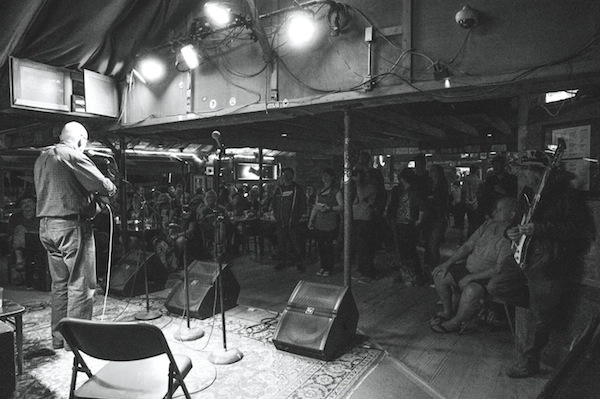
The weekly open mic night at Pappy & Harriet’s Pioneertown Palace.
I’m nodding off to sleep when heavy thunks move across the red tile roof, almost like footsteps. That’s crazy, I tell myself. It must be some kind of animal. As if in response, a cat outside the window mews in a mournful tone. I turn off the lights and remind myself I don’t believe in ghosts.
Then I hear a noise at the foot of the bed, and I flick on the lamp. A gold cowboy hat, hung from a nail on the cinder-block wall, has fallen to the floor. The impact loosens a wooden plank about the size of a paperback. It’s a homemade Ouija board. The black marker handwriting is ragged, ominous, particularly at the bottom of the board where the words “good” and “bye” are scrawled, separated by a black star. I can hardly breathe. Highway 62 unravels through the desert like a ribbon, but the road out seems so far away.
When day finally comes, the morning sky looks like a bruised knee, deep blue, mottled purple, a yellow tinge around the edges. I’ve slept a little, but not well.
Something else has happened during the night. Gram Parsons’ music hasn’t changed, but my understanding of it has. There’s a difference between listening to music and hearing it, and in room No. 8, I heard.

The Joshua Tree Lake Campground is home to the biannual Joshua Tree Music Festival, which features artists and performers from around the world. For nearly 50 years, musicians as diverse as Donovan, Keith Richards, and War have found connection and inspiration in the high desert.
Hearing the Journey
Clive Wright is one of those musicians who found his way to the high desert and stayed. His house, perched in the rocky hills above Joshua Tree National Park, doubles as his music production business, Desert Sky Studios.
In the 1980s, Wright played guitar in a band called Cock Robin, known for its songs “The Promise You Made” and “When Your Heart Is Weak.” In the early days of MTV, its videos were in regular rotation, and the band toured the world. Then Wright made several trips to the high desert and felt drawn to the place, which prompted his permanent move.
“Everyone thought I was crazy,” he says.
This is how a lot of artists end up in Joshua Tree. The logistics make sense. The high desert is close enough to Los Angeles, but far enough away that it feels like another world, free from traffic, smog, and other trappings of big-city life.
“Also I had a dog. An English sheepdog,” Wright says. “Dogs need space.”
Adjacent to his living room is a studio filled with equipment — soundboards and speakers, consoles and snarls of wire. There’s a red drum kit in the living room and a gold record framed on the wall. All sorts of people have made the trek to record in this place, from the Black Eyed Peas to local bands.
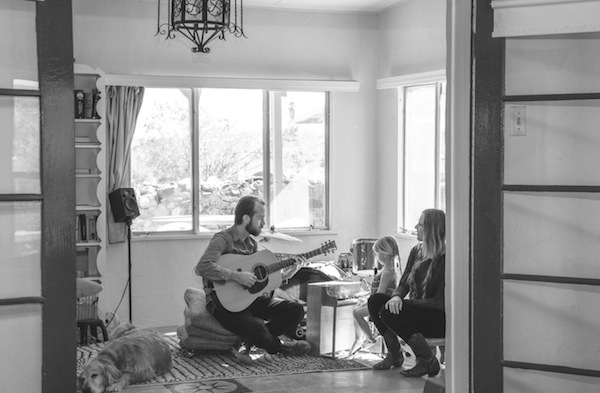
Tim and Faith Chinnock of the Adobe Collective. The couple named their band after their adobe house in Twentynine Palms. Here they are at home with their daughter, Vera.
Wright situates himself on the edge of the couch, just by the stone fireplace. The room is laced with the aroma of incense.
“I’ve been channeling something that wouldn’t have come into being had I not been here in the desert,” Wright says. “This place has its own identity, so of course that becomes a part of the music.”
Beyond the practical reasons for being in Joshua Tree, there’s something seductive about the area, and maybe a bit mystical. Time here is marked by the blooms on the cacti. The sand shifts, and forgives. Mistakes don’t leave a trail.
This is the landscape that enchanted Keith Richards, who tripped his way through the Joshua Tree National Monument with Gram Parsons, a friendship that led to the Rolling Stones’ embrace of Americana and country music. Psychedelic folk singer Donovan, the original “Hurdy Gurdy Man,” moved his family to Joshua Tree in the 1970s. Eric Burdon, lead singer of the British invasion band the Animals and member of the funk band War, has long been a desert resident, calling Palm Springs, La Quinta, and Joshua Tree home. In 1987, U2 released its seminal record of emotionally charged polemics and songs that evoked a sense of wide, open spaces. The band called it The Joshua Tree.
Back at Desert Sky Studios, I ask Wright to identify the sound of Joshua Tree, to see if he can put his finger on this thing I’ve been hearing. Just then the wind rises out of nowhere, whistling and moaning, shaking the very frame of Wright’s house. We have no choice but to be silent and listen.
“There you have it,” he says. “That’s it.”
It’s not that clear for musician Chris Unck, who doesn’t believe in a desert sound exactly. “I think there’s a desert magic,” he says.
After touring the world as a guitarist for Butch Walker, Unck crafted a successful career as a session musician/songwriter in Los Angeles, working with several acts, including P!nk and Gavin Degraw. But it was in Joshua Tree where Unck found his muse. He moved to the desert a few years ago and opened High Lonesome, a studio that offers recording, production, and songwriting services.
Unck rhapsodizes about the desert the way someone might talk about a partner after falling in love for the first time. This is not only the place that inspires him — it makes him a better man.
“Like a kid? When you’re marking his height on the side of the house? The desert has shown my growth,” he says. “It’s that visible.”
A quest to nourish the soul saturates the music here, Unck says, making it distinct from the sound anywhere else.
“The desert is such an open, inspirational area. All the musicians here are just trying to capture that,” he says. “What you’re hearing is the journey.”
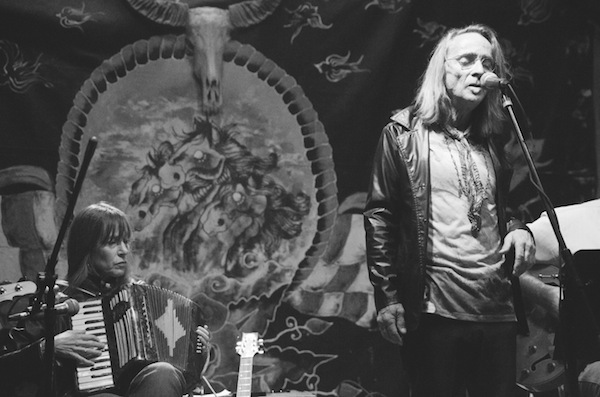
Ted Quinn (right), a staple of the local music community, describes Joshua Tree as “magical.” To his left is Lisa Mednick Powell on accordian.
Turn It Up
The Joshua Tree sound has fascinated me ever since I heard Kurt Vile’s latest release, b’lieve i’m goin’ down, which dropped last summer. All the media surrounding the album referred to Vile as a “Philly rocker,” but I couldn’t shake the feeling that he sounded downright high desert. A quick Google search revealed that Vile recorded his album at the legendary Joshua Tree recording studio Rancho de la Luna.
“I flew out to Rancho just to jam, then my family met me out there and it was like … suddenly my head was just clear,” Vile told Rolling Stone magazine last year. “It was really spiritual.”
Kurt Vile’s album is markedly different from other recordings made at Rancho de la Luna — like the albums from Palm Desert rockers Queens of the Stone Age; Humbug from British indie rock band Arctic Monkeys; and tracks from Foo Fighters, Seattle’s post-grunge darlings — yet those works all have a certain desert sensibility. So what is it?
I wonder if there’s something about the physical landscape that permeates the sound here. The diffused sunlight. The freshness of the air. Something about the rock formations. Perhaps it’s the musical equivalent of what the French call terroir, the quality that binds wine to place, infusing the grapes with the flavor of the region’s soil, climate, and terrain. Maybe a little bit of sand slips into every song.
“There’s something magical about Joshua Tree that’s hard to define,” says Ted Quinn, a staple of the local music community. “You see the stars every night, and you’re aware of your place in the universe.”
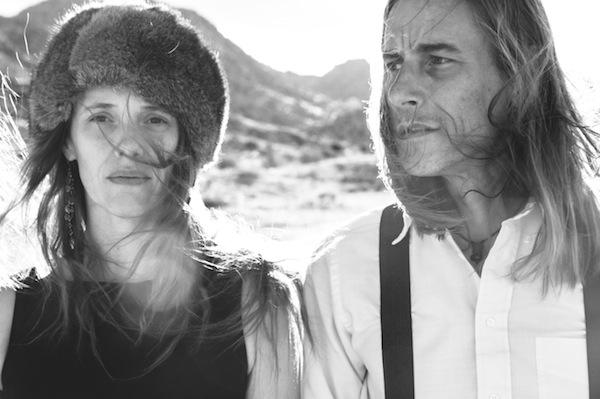
Heike Binder-Altziebler and Georg Altziebler of the band Son of the Velvet Rat. The couple moved from their native Austria to the California desert after they heard that musicians were flocking to Joshua Tree.
Whatever it is, Rancho de la Luna figured out how to capture and bottle it. It’s hard to believe this world-renowned studio had such modest beginnings.
In the early 1990s, Quinn and his friend Fred Drake regularly escaped Los Angeles and Hollywood for the laid-back, easy attitude of the high desert. During one of those trips,Drake saw a little home for rent on a dirt road. He walked around the place, clapping his hands inside each room to get a feel for the acoustics. It was a low-slung, ramshackle house, but it was a place where guitars could be played loud, where horses could be ridden, where fires could burn long into the night. Drake knew he could transform this desolate land into something special.
“He had a great ear and a vision,” Quinn says. “That’s all he needed.”
Even though Drake was weak from HIV and a desert move would mean leaving his doctors behind in L.A., he signed a lease on the place. He named the house Rancho de la Luna, a nod to spectacular Joshua Tree moonrises.
“It was a super courageous move,” Quinn says. “But those of us who love music can’t be talked out of making it.”
Another one of Drake’s close friends, artist Adriene Jenik, says that kind of courage was typical of the man.
“Horrible as it was to have this death sentence of HIV, as a result of that, Fred lived his life in this incredibly bold way. He truly was aware of not having a ton of time to make things happen,” she says. “He had this way of manifesting his visions into reality.”
Things at Rancho de la Luna fell into place as if by magic. When Drake needed sound equipment, prolific producer Daniel Lanois — who produced albums for Bob Dylan, Neil Young, Peter Gabriel, as well as U2’s The Joshua Tree — happened to be looking for a place to house his studio equipment. When Drake needed some instruments, traveling musicians left them behind.
“Whatever Fred wanted, literally within the next couple days someone would come in with whatever he wished for,” Jenik says. “It was just this little house, but little by little, it became a studio.”
He decorated the place in what Jenik calls “gay cowboy chic,” collecting thrift-store hats and festooning the walls with guitars, the holes patched up with duct tape and spackle. Every piece in the house came from the swap meet, but it never felt overdone or cluttered.
Drake died in 2002, but the heart of the Rancho beats stronger than ever with co-founder Dave Catching at the helm. The studio’s open-door policy is a little more closed than before — now bands must be invited to record there, they can’t just roll up the dirt road and walk in — but there’s still a warm fire burning, strings of fairy lights twinkle on the porch, and a pot of chili simmers on the stove.
For a humble home studio in the middle of the Mojave, Rancho de la Luna has received a lot of attention. Travel writer and chef Anthony Bourdain stopped by to make some noise and risotto during an episode of No Reservations. Then the Rancho was featured in Dave Grohl’s HBO music documentary Sonic Highways. It gets regular mentions in entertainment magazines all over the world. And if you’re in the music business, you already know the Rancho, because it’s just that good.
“There’s something really real about living here in Joshua Tree,” Quinn says. “It’s a place to create far outside the sphere of influence from corporate music. There’s nobody here telling you what to make or how to make it.”
In November 2015, the terrorist attacks in Paris thrust an unwanted spotlight onto the Rancho family. Playing that night at Le Bataclan were Palm Desert–based rockers Eagles of Death Metal — including Catching, who is a touring member of the band. Eighty-nine people were massacred at the Paris venue, including band merchandise manager Nick Alexander.
But if the Rancho has taught the world anything, it’s that when the night is darkest, it’s time to turn the music up.
In February, Eagles of Death Metal took to the French stage again, along with U2. In a statement, the band said the members of U2 “reminded us that the bad guys never take a day off, and therefore we rock ’n’ rollers cannot either, and we never will.
“Thank you to everyone in the world who continues to prove that love, joy, and music will always overcome terror and evil.”
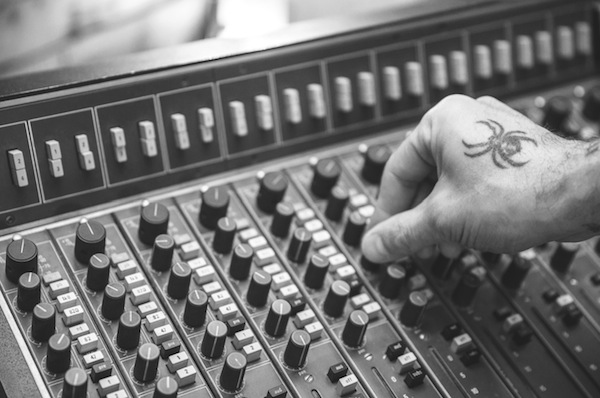
Chris Unck adjusting levels at High Lonesome.
Welcome, Stranger
Artists used to end up in Joshua Tree the way a tumbleweed blows across a road and stays put, but there’s a new crop of musicians populating the town now. They’re the folks who not only sought out the desert, but made sacrifices to be there.
Take Tim Chinnock, for instance. He and his wife perform together as The Adobe Collective, a folksy, psychedelic duo with lush harmonies that delve into the realm of otherworldly. But Chinnock also has a day job. He’s a pediatrician at Loma Linda University Medical Center, regularly making the 1.5 -hour commute from his adobe house in Twentynine Palms down Highway 62 to Loma Linda, and back again.
“We choose to be here. We go out of our way to stay here,” he says. “There’s a depth of environment here that’s woven into the music.”
He likens the high desert to an Impressionist painting, one that first might appear to be monochromatic.
“If you look at it quickly, you think what you’re seeing is just one color. But if you take the time, you discover it’s not actually blank,” he says. “The fact that everything is open to interpretation is so inspiring. There’s just so much room to create.”
That’s also what attracted Georg Altziebler and Heike Bindr-Altziebler to Joshua Tree. After their band, Son of the Velvet Rat, found success in their native Austria, the couple decided to make the big leap and move west. Really, really west.
“We heard about all the artists here [in Joshua Tree], and we knew this was the place we wanted to be,” Altziebler says.
I meet up with the couple at Pappy & Harriet’s Pioneertown Palace. The popular honky-tonk saloon is located in nearby Pioneertown, which once served as a set for old Western movies and is a most appropriate locale for meeting the band. Nowhere else in the desert embodies the mythology and romance of the old American West while embracing the unbridled spirit of the region’s musicians, artists, and creatives. This is a place where the music is sincere, the boots are dusty, and every person who bellies up to the bar could be the next big thing. (Some already are: Robert Plant, Vampire Weekend, Lucinda Williams, and Sean Lennon have all drifted through this saloon.)
Right now, Son of the Velvet Rat is one of those bands on the brink, poised to make a big splash with its next album. It’s a production with Joe Henry, who has worked with the likes of Bonnie Raitt, Billy Bragg, and Elvis Costello.
Velvet Rat’s sound is where punk rock, folk tunes, and French chansons intersect. Georg scrawls song lyrics on any available surface, including thin cigarette rolling papers; sometimes the lines are shoved into a pocket and lost, but most of the time they become something. Heike plays keyboards, accordion, and tambourine, and her voice creates the pure, vulnerable foundation underneath Georg’s scruffy croon.
Mid-conversation, Georg hops from his seat and runs across the bar to say hello to Bob Furgo, the fiddle player for Leonard Cohen.
“There’s so much talent here, and people are enthusiastic about each other’s work,” Heike says. “You don’t find that everywhere.”
Ted Quinn recognizes that talent firsthand. He was at the inception of Rancho de la Luna. Now he’s dedicated to curating the very best music in the high desert, hosting two open-mic nights every week — one at the Joshua Tree Saloon and another at Pappy & Harriet’s. He’s also the founder of Radio Free Joshua Tree, an Internet radio station that gives precious airtime to local musicians.
Sometimes the open mic nights are so popular the list fills up before Quinn walks in. Although many of the performers are locals, people show up from everywhere, including a few surprises. Celebrities who have unexpectedly taken the stage include Canadian indie singer Feist, pop star Kesha, and country rocker Shooter Jennings.
Thing is, celebrities must sign up on Quinn’s list, just the same as the retired studio musicians or the young Marine who has been practicing “Space Oddity” on his guitar. In the desert, everyone is on the same playing field.
“The idea of the open mic is to give everyone the same opportunity to play and be heard, and that’s something that directly ties into my social activism,” says Quinn, dragging a hand through his shaggy hair. “This is a space where everybody is welcome.”
What I heard that winter night in Joshua Tree Inn room No. 8 was the space where music is welcome. What I heard was the desert sound. Not just what Gram Parsons recorded, but all of it.
This is what Joshua Tree does to music. You hear it in every song’s rattling bones, the relentless wind, the sluggish hours. The desert creates slivers that wedge under your skin, linger, and haunt. It paints the colors of the day, appreciated best when you’ve already experienced the darkness.